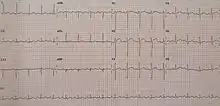ST段上升
ST段上升(ST elevation)又稱ST段抬高,是心電圖中ST節段較基準線異常上升的徵象。

正常心電圖表現,ST節段以紫色表示,紅紫相接的點即為J點。

12導極心電圖顯示第一導極、aVL、V1-V5導極中的ST段上升(橘色部分)。下導極則顯示對應性變化變化(藍色部分),顯示有一心臟前壁梗塞。

An example of mildly elevated ST segments in V1 to V3 that are concave down
測量
若肢導極在J點後0.04秒的基準線上升大於 0.1 mV (一小格),或胸前導程基準線上升大於 0.2 mV (兩小格),則視為有意義的ST段上升[1]。基準線可參考PR間期(PR interval)或TP間期(TP interval)[2]。這種測量方法的偽陽性率約為15-20%(且女性高於男性),偽陰性率則為20-30%[3]。
生理學
ST節段在心臟電氣生理中所代表的意義為心室收縮後的等電位期。在這段時間理論上不應有過大的靜電荷流動。
透壁性缺血
在透壁性缺血的狀況下,受影響的心肌細胞的鈉鉀泵無法繼續運作,致使再極化不完全,因此電位會相較其他運作正常的細胞為高。同時,由於再極化不完全,負電荷會累積於膜表面,因此在心電圖上會產生指向正常細胞的電流向量。產生的向量與導極方向相反,致使TP節段下降。但由於TP節段為心電圖的參考基準線,因此相對而言ST節段看起來就上升了。
相關疾病
與ST段上升關聯的病理狀況有:
參見
- ST節段
- ST段下降
參考文獻
- Family Practice Notebook > ST Elevation (页面存档备份,存于) Retrieved Nov 2010
- Khandpur, R.S. 2nd. New Delhi: Tata McGraw-Hill. 2003: 255 [2018-03-14]. ISBN 978-0-07-047355-3. (原始内容存档于2017-10-06).
- Sabatine MS. . Lippincott Williams & Wilkins. 2000. ISBN 0-7817-1649-7.
- Thaler, Malcolm. . Lippincott Williams & Wilkins. 2009 [2018-03-14]. ISBN 978-1-60547-140-2. (原始内容存档于2014-12-18).
- Tingle LE, Molina D, Calvert CW. . American Family Physician. November 2007, 76 (10): 1509–14. PMID 18052017.
- Chew HC, Lim SH. (PDF). Singapore Medical Journal. November 2005, 46 (11): 656–60 [2018-03-14]. PMID 16228101. (原始内容存档 (PDF)于2016-03-03).
- Victor F. Froelicher; Jonathan Myers. . Elsevier Health Sciences. 2006: 138– [2010-10-10]. ISBN 978-1-4160-0311-3. (原始内容存档于2013-05-28).
- Plautz CU, Perron AD, Brady WJ. . The American Journal of Emergency Medicine. July 2005, 23 (4): 510–6. PMID 16032622. doi:10.1016/j.ajem.2004.03.014.
Template:Heart diseases
This article is issued from Wikipedia. The text is licensed under Creative Commons - Attribution - Sharealike. Additional terms may apply for the media files.